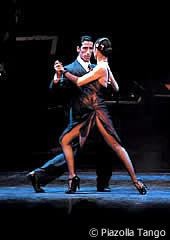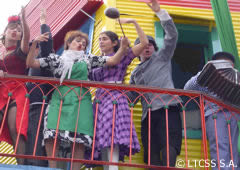Tango was born cunning, deep, forbidden and related to brothels. It started to become a deep dance, a “sad feeling that is danced”, as Enrique Santos Discépolo would define it years later.
Tango became so popular that it ended up reaching persons of different backgrounds who were eager to make from tango their own passion.
As every spontaneous cultural phenomena that emerges as a social expression, it is hard to establish exactly the date in which tango was born. The truth is that everyone recognizes its origin in the year 1880 when in the outskirts of the city, the evil characters of the “knife and courage sect” (as described by Jorge Luis Borges in his poem “TANGO”) had the direct intention of inventing a dance that could embrace and seduce women.
This style started to manifest itself in improvised steps as street musicians played short chorus that they recreated and made popular but that were never registered. Some researchers make reference to naughty improvised lyrics with no poetic intentions but it is believed that the first tango attempts were instrumental and meant to be danced. The style was upbeat as a contrast to the characteristics that would define it through its development. The aim was always to seduce women through tight-dancing skills filled with strategies to make bodies touch that resulted in loads of sensuality. The way to uncover the secrets of tango steps and skills was developed by men who rehearsed in the corners before making an approach towards those coveted women. The setting were the dance rooms, called “academias” (academies), that were considered to be “casa de citas” (dating houses), where promiscuous ladies worked. It is said that this is the place where tango shaped up and developed along with other emerging music styles as milonga, the habanera and the canzonettas. Immigrants and locals used to go to this places which makes it obvious that from the mixture of cultures, specially from the Italian and Spanish cultures, tango originated.
But… where does tango appear? Which are its models? How does it settle and root in the Río de la Plata? There are as many versions, followers and detractors of each version as people who like tango.
Among the most popular versions are the ones that find the influence of the Cuban rhythms of La Habana, others state that the black origin derives from many hypothesis related to the origin of its name and its meaning. The word “Tango” means “touc h or feel” for Africans, which gave place to the usage of the word “tan-gó”* for the patches that fixed percussion instruments. There is a city called Tango in the African continent. The black community in Cuba used the word tango as the definition of “dance”. With similar meanings, in Spanish, the word tango comes from the Latin word “tactum” that means to touch: an object, a place (harbor) or someone else. According to Horacio Ferrer’s book “La historia del tango” (Tango’s history), the usage of “touch” expands to symbolize the actions of being moved, beaten, hurt, of composing lines from time to time and of talking about an issue. In ancient Spanish, the verb “tangir” (touch) implied to play an instrument.
h or feel” for Africans, which gave place to the usage of the word “tan-gó”* for the patches that fixed percussion instruments. There is a city called Tango in the African continent. The black community in Cuba used the word tango as the definition of “dance”. With similar meanings, in Spanish, the word tango comes from the Latin word “tactum” that means to touch: an object, a place (harbor) or someone else. According to Horacio Ferrer’s book “La historia del tango” (Tango’s history), the usage of “touch” expands to symbolize the actions of being moved, beaten, hurt, of composing lines from time to time and of talking about an issue. In ancient Spanish, the verb “tangir” (touch) implied to play an instrument.
There is a lot more to say and discover about tango and about the origin of the word that is coined in the customs and influences of Japan and of the South of The United States of America.
The truth is that the sum of all these theories attached to the social phenomena of the men forged in this Southern lands, who was a mixture of natives and immigrants, added to his cultural background gave place to the “porteño”, who adopted an identity, a way of being, of feeling, of being passionate and who found in Tango the ultimate way of expressing himself. Therefore, we can say that tango and the porteño were born and raised together.